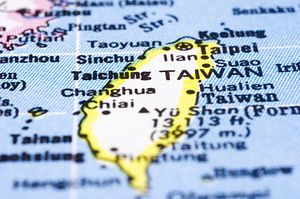Immediately after the historic Xi-Ma meeting in Singapore some two months ago that culminated in the first handshake of the two rival leaders in 66 years, the Global Times in Beijing ran an editorial headlined “1992 Consensus ensures lasting cross-straits peace,” claiming the meeting’s biggest highlight was that both sides had shown a strong commitment to the “one China” principle.
Ironically, the last-minute drama on the eve of Taiwan’s general election, when teen pop star Chou Tzuyu apologized for waving a flag of the Republic of China in a video clip, tore to shreds the 1992 Consensus – supposedly the cornerstone and prerequisite for peaceful cross-straits relationship. This incident also became the final straw that broke the back of the pro-unification Nationalist Party (KMT) in its most disastrous election rout.
Mainland netizens reacted angrily towards Chou’s ROC flag-waving episode, accusing the singer of “earning RMB while holding a pro-independence stance.” The incident raises these critical questions: Do Mainland audiences properly understand the true meaning behind the untested consensus? Has the Mainland and its powerful propaganda apparatus ever appropriately explained the 1992 Consensus to the public? Far more importantly, to what extent, scope and scale can Beijing allow Taipei’s different interpretations of one China?
The 1992 Consensus forged in Hong Kong in that year became known literally as the principle of “one China with different interpretations,” and is a tacit agreement. Although unsigned, it is still better than nothing, with both sides seeking common ground while reserving differences. Unfortunately, however, the reality is far more complex, especially when it comes to “operational level.”
For instance, waving the ROC flag rather than the Five-Star Red Flag might be considered by the Taiwanese side as their interpretation of China. Even the People’s Daily published an article on its social media account admitting that it was unfair to label Chou Tzuyu as a “Taiwanese separatist” for waving the ROC flag, adding that “the expression of the ROC contains [the] one China principle.” Despite this, all Mainland media have in the past tried their utmost to block out the ROC flag. If the floodgates are now allowed to open, the ROC flags rarely seen in many eye-catching events at venues such as stadiums could begin appearing with increasing frequency.
Undoubtedly, it is Beijing’s consistent and unyielding stance that both sides across the Strait should restore consultation and talks on the solid foundation of the “one China” principle. That stance will remain unchanged. The crux of the issue is “different interpretations.” In fact, Beijing has been hesitant and cautious when it comes to “agreeing to differ on one China’s definition.” This may explain why the Mainland authorities for the first time used the term of 1992 Consensus only after 2000.
The hidden cracks in the 1992 Consensus will always be there. Chou’s coerced apology initiated by her South Korean management company triggered a flood of debate, making the 1992 Consensus shaky, if not “earth-shattering” as some pundits put it. The People’s Daily admitted on social media that under the 1992 consensus, the ROC’s existence should indeed be accepted as it complied with the ‘’one China’’ principle, and the recognition of the ROC did not amount to a ‘’pro-independence’’ stand. On the other side of the Straits, the KMT was mocked by angry and frustrated Taiwanese for the party’s wishful thinking that Beijing would agree with its ‘’one China’’ being separately enunciated.
The misunderstanding highlights differing and often contradictory official discourses over the consensus on both sides. Besides, as a “modus vivendi” the 1992 Consensus has a few other flaws: It is not legally binding, lacks sustainable and logical narratives, and is much less operational than “One Country, Two Systems.”
To calm the troubled waters across the Taiwan Strait in the long run, it would be beneficial for both sides to diminish the ambiguity. Beijing’s policy toward Taiwan over the past few years is commonly judged to have been successful, and looks set to remain so. However, it may not yet be ready to accept full-blown “different interpretations of one China,” or to put it more explicitly, to treat the island as an equal political entity under the one China banner. On the one hand Xi and Ma addressed each other as ‘’Mr.’’ at their candid and harmonious meeting; on the other, permitting differing discourses makes it too easy to draw blurred lines about “two Chinas.” The Chou episode actually underscores the urgent need to end the ambiguity.
Indeed it is vital for Taiwan’s newly elected government to remove the ambiguity. There is no doubt that Tsai Ing-wen is milder and more pragmatic than her DDP predecessor Chen Shui-bian, and has so far not openly advocated “Taiwan independence,” generally favoring the cross-strait status quo. But she has never openly accepted, or even hinting at complying with the 1992 Consensus. Although Tsai always shies away from media queries on the 1992 Consensus, it is inevitable that she will have to outline her policy toward the Mainland during her inauguration speech in May. While she must please her independence-leaning DDP comrades who helped her secure a commanding win in last week’s general election, she also must honor her election promise by striving to maintain the cross-strait status quo, which means she needs to do something substantial to set Beijing’s mind at ease.
Dr. Bob Lee, currently chief writer and senior editor of China Daily Asia Pacific, is a veteran journalist who has been working for Western media as well as media in Mainland China and Hong Kong for over three decades. He got his Ph.D. in political science at Peking University, and was a visiting scholar of National Chengchi University (NCCU) where both incumbent president Ma Ying-jeou and president-elect Tsai Ying-wen once held professorships. Dr. Lee has gained his expertise and insight in Taiwan affairs by engaging in frequent academic exchanges across the strait and observing almost every general election since Taiwan’s democratic transformation.

































